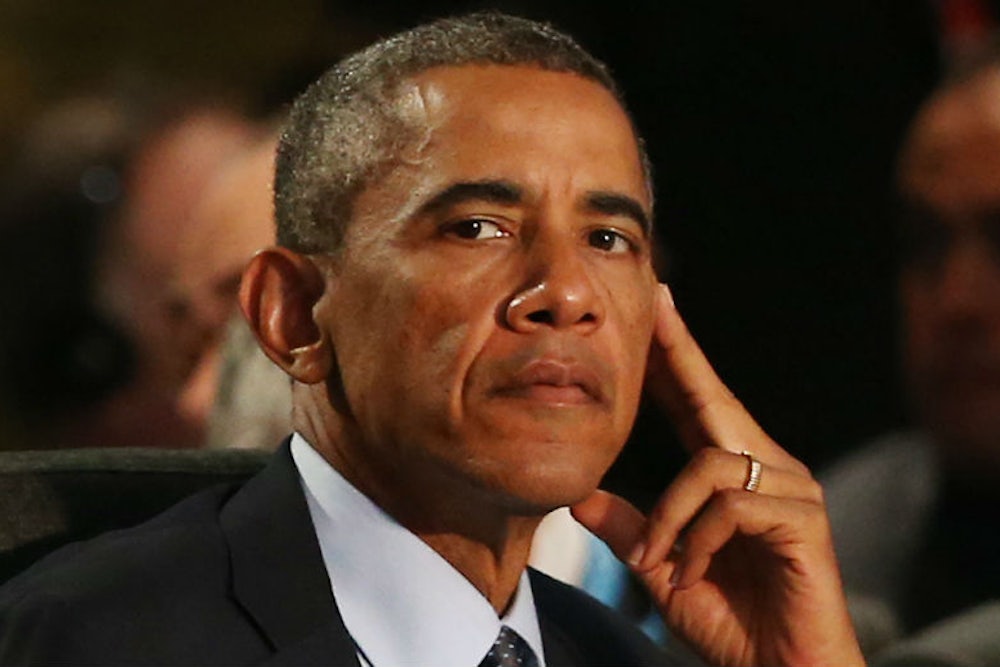No matter one’s politics, there is something disconcerting about America’s sudden swerve toward war. Last year, a reluctant Congress and jittery public yanked the president back from unleashing strikes against Syria’s brutal Assad regime. Now, a year and three videotaped beheadings later, everything has changed. With widespread public approval, the president has announced the start of a campaign to pursue and “ultimately destroy” the Islamic State, Assad’s most dangerous opponent. So even if we support this intervention, we must ask: Have a series of monstrous but strategically insignificant murders spun around the largest war machine in human history?
More than most, President Obama’s mind is a cipher. But chronology and history suggest his decision to go to war was a gradual and deliberate one, motivated by strategy rather than optics and politics. Ever the gradualist, President Obama has been accelerating actions against the Islamic State since well before the killings of journalists James Foley and Steven Sotloff, and he has done so in response to consequential military developments. Last Thursday’s announcement is not a sudden poll-driven shift or ill-conceived emotional reaction, but the culmination of a cautious response to a strategic threat.
The rapid development of Obama’s strategy over the past week has given birth to two related and pernicious narratives. In the first, pundits as different as Charles Krauthammer and John Judis argue that our president is fickle, easily swayed by graphic images and sudden surges in public opinion. In this account, although constitutionally opposed to intervention, President Obama has been unable to resist an outraged public and sustained criticism from diplomatic heavyweights like Ryan Crocker and Hillary Clinton. And in a second narrative, anti-interventionists like the Nation’s William Greider warn that war hawks have desperately wished to intervene in Syria for some time, but have needed an outrageous casus belli to galvanize public support. Now, these cynical war hawks have successfully channeled Americans’ visceral horror at the recent grisly murders to serve long-standing desires for intervention and silence their critics.
Neither narrative, however, aligns with the facts. Obama began ramping up interventions in Iraq well before these murders, and he did so in response to substantive strategic realities. It was in mid-June that Islamic State militants routed the far larger and better-equipped units of the Iraqi army. Only days later, reports began to surface that President Obama had offered air strikes in support of the Iraqi military, but made them conditional on Prime Minister Nouri al Maliki’s resignation. On August 7, IS militants seized the crucial Mosul Dam. The same day, profound humanitarian and strategic considerations forced President Obama to compromise somewhat on pressuring Maliki, as he authorized his first air strikes to protect the besieged Yezidi population and to bolster buckling Kurdish forces. Around the same time, the U.S. began to build the international coalition against IS that would emerge weeks later. On August 15, Maliki finally caved to international and internal pressure and stepped aside, and on August 17, American forces helped the Kurds retake the Mosul dam. All of this occurred well before the video of Foley’s murder went online.
This chain of events does not look like a sudden reversal after pressure from post-beheading opinion polls. It looks like a roadmap to war: a steadily detiorating strategic situation, an expressed American willingness to strike predicated on the meeting of a condition, the fulfilment of the condition, the extremely successful implementation of a limited American air campaign, widespread public support. Throughout this process, the president may have harbored misgivings and wished to proceed cautiously, but it was the force of strategic events that pulled him along, not emotional outrage and poll numbers.
But memories of Bush-era claims of WMD have accustomed too many to suspect subterfuge whenever public clamor accompanies a president’s march to war. In this case, though, the facts show otherwise. First, the sudden change in the Obama administration’s legal justifications for the use of force—from implicit use of constitutional authority to explicit reliance on the 2001 AUMF (and now, perhaps, the 2002 AUMF as well)—demonstrates that an expanded military campaign was never, for the administration, a foregone conclusion. The administration’s military goals changed, and so the legal basis needed to evolve as well. Similarly, as recently as a month ago, even when unleashing strikes in defense of the Yezidi on Mt. Sinjar, Obama bent over backward to emphasize the narrowness of the campaign. His remarks that night were not those of an administration hoping to take his country to war only a few weeks later. And at the same time, even with a strong popular majority behind strikes in Iraq—nearly double the number that supported him a year ago against Assad—President Obama held back from a full-scale roll-back of IS. Only after the threat took clear form, after he had time to deliberate and reflect, after the Iraqi government met his conditions, and after he was able to put together a robust international coalition, was the president ready to make his announcement. The timing of the murders was coincidental.
The story of this war is thus less intriguing than the conspiracies and criticisms suggest. Fast-moving strategic realities compelled a reluctant president to act. He has done so gradually and hesitatingly, but as conditions have been met, alliances have been formed and early actions have proved successful, he has grown bolder. We cannot yet know how this war will end, but we can be confident in how it began.
